Journal of
eISSN: 2378-3184


Review Article Volume 2 Issue 3
Department of Marine Biology, Bangor University, UK
Correspondence: Jennah Williams, Department of Marine Biology, Bangor University, 4421 Mariannes Ridge Rd Charlotte NC 28273, UK, Tel: 7046121880, Tel 7046121880
Received: May 14, 2014 | Published: June 22, 2015
Citation: Williams j (2015) Are Jellyfish Taking Over The World?. J Aquac Mar Biol 2(3): 00026 DOI: 10.15406/jamb.2015.02.00026
Jellyfish have roamed the Earth since the dawn of time; inhabiting all of the world’s oceans, continuously evolving and developing into the versatile, dominant species they are today. However, recent studies are now accentuating that jellyfish population’s bloom are more frequent and are continuously increasing in size and therefore has become quite problematic and are in fact a threat to the natural balance of marine ecosystems and towards human beings as a whole, with increases as large as 94,000 tons escalating to 400, 000,000 tons in wet weight over a 100 km area in just 5 years. Increased human activities such as over-fishing, global warming, eutrophication, translocation and habitat modification are shown by investigations to be the main reasons for this sudden global outbreak in jellyfish, suggesting that with the recent increase in human population continuously rising, matters are potentially worsening. The jellyfish epidemic is creating irreversible disturbances within the ecosystem, ultimately becoming the dominant species over fish within many global areas, by filling the newly provided ecological niche created by overfishing, in which due to the jellyfish’s diet, could be potentially an irreparable change, in which the fish cannot return back to dominance and the jellyfish’s rein continues to grow. Tremendous negativity surrounds the ever growing jellyfish blooms affecting costal industries in Japan, to tourism in Australia and aquaculture farming within a variety of species worldwide. The present study acts as a literature review of current research into the effects jellyfish population increase, is having on the marine environments worldwide. Upon review, it is concluded that research supports the notion that populations are increasing to such a level that the question ‘are jellyfish taking over the world?” can be answered agreeing with the statement and the need for preventing the escalation of such a development is paramount; before such action is futile and ineffective. Subsequently, arising complications shall be discussed and possible procedures to act as a solution shall be suggested in an effort to potentially reduce the influx of jellyfish throughout the world’s oceans. Future research is also considered to potentially put an end to the outbreaks, suggesting that very little is known about the creatures way of life and that if better understanding of the organisms was obtained, then perhaps the jellyfish take-over would finally be put to a halt.
The abundance of jellyfish worldwide is said to be increasing severely throughout marine ecosystems. Overfishing, climate change, eutrophication, habitat modification and translocation, as well as other factors influenced by human activities, promote high frequency of jellyfish blooms, which, in turn, are responsible for negative effects on many marine species.1 The Richardson et al.1 study highlights the deterioration of an Osteichthyes dominated ecosystem, to see it replaced with an increasingly gelatinous populous. As a result jellyfish, not fish, threaten to become the dominant animal group of the marine world. The effects of this are seen to be robust with a significant negative influence on the economy and ecology of the environment. Jellyfish fall in to the phylum of Cnidaria, but are also categorised as a gelatinous zooplankton organism; interestingly, such gelatinous species (including ctenophores, medusae and salps) can range in size from the 2 metre wide giants; Nemopilema nomurai to the tiny and microscopic Malo kingi. They are found in habitats ranging from the deep abyss to the surface of any ocean, lake, large rock pool or estuary throughout the world,2 this being said, growing medusae numbers are generally found more frequently in shallow, contained areas, with a low tidal exchange rate.3 As a prime example of the increasing abundance of these organisms in recent years, the giant jellyfish Nemopilema nomurai was recorded between 1920-1995 in Japan’s inland sea ‘Seto’ to bloom once every 40 years.4
However, records from 2002-2006 have shown that the blooms have become annual and have tripled in size, with a recorded bloom of 9.4 x 104(94,000 WW) tons of wet weight jellyfish extending along a 100km coastline in 2000, expanding again in 2005 to 4 108 (400,000,000 WW) tons per 100 km4 emphasising a large increase in jellyfish numbers travelling through the Tsushima Strait daily as shown in Figure 1.4 These figures suggest that jellyfish populations are increasing worldwide and that severe consequences may occur if controlling precautions are not implemented. Within this piece of literature the causes and effects of jellyfish population increases are debated. Subsequently, arising complications shall be discussed and possible procedures to act as a solution shall be suggested in an effort to potentially reduce the influx of jellyfish throughout the world’s oceans. Upon review of current literature, the question, “Are jellyfish taking over the world?” Shall be addressed.

Figure 1 The increase in Nemopilema nomurai abundance along the 100km coastline of the inland Japanese sea Seto, over a 5 year period. The 2005 recording was one of the biggest recording of these giant Jellyfish Japan had ever seen.4
Life cycle of a jellyfish
The term jellyfish is a very general expression covering a myriad of animals from different classes, phyla and sub-phyla. Cnidaria such as these are members of a large gelatinous family of zooplankton and within this family, different species fall in to different categories of animalia (Table 1)5 Scyphozoans (true jellyfish) reproduce both sexually and asexually, depending on the life stage; Sexual reproduction takes place during the medusae stage, whilst asexual reproduction takes place during thepolyp stage.6 The Lucas6 investigation highlights the notion that during these life cycle stages, population distribution is affected by the mortality rate of the young during early development within the polyp stage. Therefore annual abundance of larger matured jellyfish ultimately depends on the mortality ratio of the polyps in the juvenile stage. Jellyfish have been known to differ in their lifespan pattern depending on the species. The larger species on average live longer than the small, ranging from a span of a few hours to many years, study show that the larger the species the longer the life span,6 this may offer an insight into the more colloquial awareness of larger species of jellyfish (i.e. Dustbin lid Rhizostoma octopus).
Table 1 Marine Zooplankton (jellyfish) taxa information: Taken from Census of Marine Zooplankton Guide5
Some jellyfish reproduce daily, in accordance with higher water temperatures.4 This could potentially offer explanation as to why larger blooms appear in the warmer waters around Japan and China (Figure 2).7 All Jellyfish species reproduce in the same way; however this process requires several different stages of development.8 The medusae (adult) reproduce sexually, in which the male releases sperm into the water through an opening in his ‘mouth’ under the ‘bell’, which is then either ingested by the female, fertilising the egg, or the eggs are also released into the water mixing with the sperm, when the water temperature increases reaching 20°C the Planula start to develop.4 The planula (larvae stage) will then drift in the water column for approximately a week before attaching itself on to a hard substrate in either deep or shallow water to develop into a polyp.8 The asexual polyp phase (lasting several months to several years depending on the species) then metamorphoses into the ephyra stage, cloning them several times in the process.8 From the ephyra the jellyfish finally blooms into adult medusae, growing as large as 2 metres wide (Nemopilema nomurai). That being said, the adult medusae do not normally live more than a few years. In contrast to this, the Turritopsis nuticluade fies the life cycle of the species, through the mutation of its cells in a process reverting it to its juvenile state upon reproducing at its fully sexually medusae phase.9 Making this specific jellyfish; almost ‘immortal’, accentuating its common name, ‘The Immortal Jellyfish’ Turritopsis nuticlua.
The immortal jellyfish
Recently, more attention has been directed towards Jellyfish changing the notion they are not merely a ‘dead end’ in the marine food chain as previously considered.10 Hongbao & Yang9 analysed the strange alteration in cells within the almost alien species Turritopsis nuticlua recognising that it could in fact revert back to a polyp state after it had reproduced (unlike some jellyfish which simply die after dispersal). Studies have shown jellyfish numbers rapidly increasing as these creatures “need not die”. Dr Maria Miglietta of the Smithsonian Tropic Marine Institute emphasised in a recent interview about the sudden increase in numbers; that we are getting ready to take on a “world-wide silent invasion!” Dr Miglietta then goes on to say that these specific jellyfish were once only native to the Caribbean islands, but are now populating worldwide. So far this hydrozoan is the only known creature on the planet to have evolved the capability of transforming completely in to its younger state. Trans differentiation makes this cycle of cell development possible and it is indefinitely repeated, therefore presenting this creature as somewhat immortal; suggesting jellyfish are developing new ways to thrive and survive to eventually be the dominant species in many ecosystems.9
History of jellyfish: When did they arrive?
Jellyfish are known throughout the world as alien-like soft bodied organisms, with no brains, vital organs or even bones. In fact jellyfish have no calcified features, they simply possess a basic nervous system, consequently, jellyfish fossils distinctly uncommon, thusly making it hard to date their first appearance on earth, but not impossible. In recent years discoveries have been made of jellyfish fossils ranging back to the Cambrian age of approximately 505-550 million years old,11 therefore suggesting that jellyfish have been present since life’s basic beginnings, when the ancestors of modern jellyfish are likely to have dominated the oceans.12 Japanese history books refer to jellyfish ruling the oceans in early years, such history books as the ‘Kojiki’ (the oldest history book in Japan) published in 712 AD, emphasise that when Japan was first discovered, hundreds of thousands of medusa swamped the Japanese sea’s surface.4
Abundance increases throughout the years: Uye4 explains that over the past few decades the jellyfish population has increased tremendously. The problem of amplified biomass of jellyfish in Japan was first sighted in the early 1960s in Tokyo Bay, at this time there was great uproar about increasing industrialized sewage discharge being drained into the sea, this was then later said to be due to the increased A. Aurita medusa blooms clogging the power plants cooling systems, Uye4 as explained later in this document. However during the 1980s population increase of A. aurita became significantly worse throughout Japan, disrupting fisheries, power plants and food supplies, leaving Japan with a rapidly rising gelatinous population problem, which subsequently was to intensify. During the early millennium (2000) Japan was then swarmed by the second largest jellyfish ever recorded Nemopilema nomurai, this then caused one of the biggest blooms to date, which then went on to develop in to the largest recorded bloom seen in Japan in 2005, (Figure 1)4 proving that the increasing jellyfish population was becoming a real concern. A study was also conducted in Namibia in 2006 to estimate the jellyfish biomass compared with the fish biomass of the area, associated with past decades. In the 1960s reports of increasing Chlysaora hysoscella around the area were becoming more apparent, since this time jellyfish increasing population reports have been more recent and today investigation shows that numbers have increased to the point at which jellyfish biomass outweighs that of its fish counterpart.13 This recent evidence suggests that jellyfish abundance has increased alarmingly over the last decade, possibly predicting the progression of jellyfish as the dominant species within marine environments (Figure 3).14

Figure 3 Fossil of Cambrian age Jellyfish found in North America- Utah.11
Are humans to blame for the causes of increasing jelly numbers?
Over the last few centuries jellyfish population has increased rapidly. This may be due to a number of, what are said to be known, reasons. Climate change, overfishing, eutrophication and translocation are just a selection of plausible causes as to the species escalation. Evidence suggests that the majority of explanations for increased jellyfish abundance are resultant of human activities; furthermore these activities often elicit a causal relationship with jellyfish blooms.1 Richardson et al.1 explain that there is convincing evidence to suggest that these human induced activities; do in fact lead to an increase in jellyfish abundance. The most dramatic climb in abundance is said to be due to climate change.
Climate change: The slowly rising temperature of the world’s oceans is one of the said causes of the world-wide jellyfish increase, global warming creates benefits for some organisms and complications for others and current evidence suggests that it is a desirable change for jellyfish. Recent studies show that the warmer temperatures stimulate the reproduction of medusa; as the ideal temperature for jellyfish to reproduce is 20°C, therefore as the water temperature is increasing; the average temperature does not often fall below 20°C; which emphasises that climate change is causing a rise in sea temperature and with this, an unavoidable rise in medusae (Figure 4a & 4b).15,16
Uye4 explains that global warming has affected many different, if not all, areas of the world, the Yellow Sea in East China was of particular interest for Uye;4 the investigation noted that sea temperature had increased by almost 2°C between the years of 1976-2000; subsequently, the paper divulges that jellyfish reproduction became more frequently in higher temperate waters and since scyphistoma (Table 1)5 reproduce asexually, no partner is needed. Consequently, reproduction can occur multiple times and more frequently. As the water is warming and asexual reproduction is occurring at an increased rate, the medusae birth rates increasing rapidly.4 Advances in “net systems, diving distributions and abundance patterns” have coincided with climate change correlations such as “El Nino” the “southern oscillation” and “the north pacific decadal oscillation”.2
Climate change has the potential to alter many characteristics of the sea, occasionally changing nutrient fluxion as well as temperature2 which may induce changes in food webs and shifts in the marine ecosystem, for example in a Norwegian “fjord” the population abundance is mainly jellyfish. As a result, fish have become a very rare inhabitant; due to the consumption of fish larvae and eggs by Jellyfish.2. Lynam et al.13 and Mills17 also argue that jellyfish proliferation is likely to be due to climate change, from either direct impact or in response to the environmental concerns on fish abundance and distribution. Lynam et al.13 suggest that an El Nino event in Benguela (1963) assisted in the rapid decline of the sardine biomass, which could have presaged the sudden influx of jellyfish in this area. The North Atlantic has a significant link between climate and jellyfish abundance.13 During the winter of 2005 the N Atlantic oscillation was suffering in a distinct destructive state and it was suggested that if these patterns persisted, this would result in a large outbreak of jellyfish in coastal waters on both sides of the equator (Figure 5).15,18

Figure 5 Average Global Sea Surface Temperature 1880-2009, showing the temperature against the year.15
Over fishing: Overall jellyfish population has shown an increase over the past decade, simultaneously coinciding with the fishery market revealing huge problems concerning declining fishery resources.19 Worldwide, the quantity, size and distribution of large predators is declining, many of these species are predators of jellyfish, i.e. the pacific salmon, tuna, cod, sharks and, the main predator of the jellyfish; sea turtles, as a result of overfishing.4 The Yellow Sea is a prime example of declining fish numbers, providing a decrease in catches from 13x104(130,000)tons in the late 1980s, to less than 5x104(50,000) tons in 2004; this enormous decrease in fish catch may present the opportunity for jellyfish to overcome the dwindling number of predatory fish and invade the respective area.4
Throughout the last century, fishing has led to a global reduction in average levels of commercially harvested fish13 this has shown a significant decrease in large predators compared to invertebrates and plankton consuming species found in the pelagic and low tropic areas; furthermore a problem this is creating is an explosion of suppressed zooplankton (jellyfish) consuming the food that the absent fish are no longer thriving on.13 Lynam et al.13 investigated the area of Beriguela, near Namibia, to review the impact of increased jellyfish biomass and to assess the jellyfish increase. The study produced astounding results, with jellyfish biomass (12.2 million tonnes) exceeding triple the biomass of the once dominant fish population (3.6 million tonnes) thusly suggesting that the jellyfish invasion is having negative effects in a variety of areas of the world. This region was once home to a vastly populated fish stock, including such species as, sardines and anchovies, however recent pressure on the fisheries has seen reduced fish stocks and landings have declined in the last 40 years from 17 to 1 million tonnes.13 However, before this time, jellyfish did not reside in this particular ecosystem; their presence has exploded in a substantial number of areas worldwide; a problem, Lynam et al.13 attributes to the result of substantial over fishing.
However dramatic declines in jellyfish predators as a result of by catch or over fishing may also be a reason as to why overfishing potentially causes complications, not only does it remove the fish from the ecosystem, thusly allowing jellyfish effectively a ‘free reign’ of the environment, in the removal of predators, the jellyfish are provided with less threat from predators. The leatherback turtle (a major predator of jellyfish), faces the very real danger of extinction, this would likely result in increased jellyfish populations due to the absent turtle population no longer feeding. Leatherback turtles are the largest marine turtle in the ocean, surprisingly enough, these giants feed on rather small jellyfish. They rely greatly on jellyfish to satisfy their nutritional needs, consuming the equivalent weight of an adult lion in jellyfish (440 lbs.) in a day.20 Wilson et al.20 highlight the essential role Leatherbacks play in the predation of jellyfish and a decline in leatherback populations could have positive effects on jellyfish population numbers and could be a reason for the silent take over from a once fish populated ecosystem to a jellyfish abundant ecosystem.20 A study was conducted in Malaysia between 1968 and 1994 to monitor the abundance of leather back turtles over a specific area.21 The results of the study showed an alarming decrease in turtle numbers, showing that in 1968 when the project first started there was a total female turtle population of 3103 in Malaysia, however that number rapidly declined in 1978 to just under 600 marine leatherback turtles, since 1978 numbers have reduced further; in 1980 there approximately 200 turtles roaming the waters, unfortunately the numbers dropped again, resulting to just 2 female leatherback turtles accommodating this area by 1996.21 Figure 6 22 also shows the severe population decrease in Leatherback turtles in a different part of the world; this study in Costa Rico from the 1980s to the late 2000s emphasises again; that turtle abundance is falling worldwide.
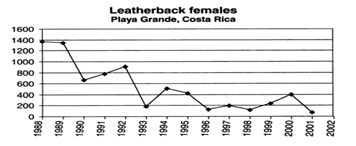
Figure 6 The dramatic decline in female Leatherback turtles in Costa Rica between 1988-2002.22
Loggerhead turtles and Green Turtles are also known predators of Jellyfish, As these species abundance numbers are also declining, the jellyfish population is continuously growing and growing; with few predatory threats in their path.20 This being said, turtles are not the only predatory species affected by overfishing; Elasmobranchs, specifically shark populations, are declining rapidly across the world.23 In the North Atlantic Ocean shark numbers have declined greatly in recent years, the fish stock assessments done on sharks in this area, have come to show that species such as the Smooth Hammerhead (Sphyrna zygaena), the dusky shark (Caracharhinus obscurus) and the great hammerhead (Sphyrna mokarran) have reduced in population numbers from 60% to 80% recently . The Tiger shark is also being considered for the endangered /prohibited species list in Florida, Tiger Shark numbers have plummeted in recent years due to the huge amount of by-catch of these animals.23 Fisheries with in the US Atlantic ocean use long-lines to fish large predatory sharks such as the black tip shark (Carcharhinus limbatus) using a line up to 24km long with up to 1500 hooks.24 With the large amount of overfishing on the species, plus the vast by-catch of species like the tiger shark, shark populations are rapidly declining, again creating an opening for another predator, namely the jellyfish, stand in place.
Reasons for the rise in jellyfish abundance explained
Climate change: Climate change is defined as a permanent and substantial change within the weather that ultimately affects different attributes on Earth. Examples of climate change, is the increasing temperature of the Earth, currently warming oceans (El Nino), melting ice caps causing rising oceans and extreme weather conditions from floods to cyclones due to the changes in solar radiation and the variation in greenhouse gases, which is said to be undoubtedly getting worse (Figure7).25

Figure 7 Emphasises the increase in global temperatures during the last century.25
Over fishing: Overfishing initially is the process in which total catch of a species is higher than the maximum percentage allowed to be fished, for the species to recover and reproduce without said species becoming extinct and is said to be an unsustainable use of our oceans, ultimately if over fishing carries on at the rate it currently is, this could in itself results in a mass worldwide invasion of jellyfish (Figure 8).26
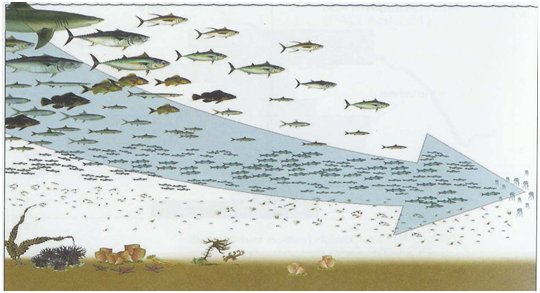
Figure 8 Emphasising that overfishing could eventually lead to an invasion of jellyfish.26
Reasons for the rise in jellyfish abundance explained continued
Eutrophication: is nature’s aquatic response to the addition of foreign substances (Figure 9)27 whether they are natural or via human activity, for example excess nitrogen (limiting nutrients to the ocean) or run off fertilisers and sewage increase from untreated pumps. Eutrophication is known to negatively increase plankton blooms resulting in a hypoxic water state, again leaving room for the jellyfish to invade due to their success of reproduction in oxygen depleted waters.1

Figure 9The processes in which Eutrophication occurs within the marine environment.27
Translocation: Is the movement of a species from one location to a different area via human involvement; whether it is deliberate or otherwise, for example exchanging of water that is contaminated with phytoplankton or the transportation of an organism due to it being attached to objects such as a boat1,28 (Figure 10) .

Figure 10 Emphasising human activity creating translocation.28
Eutrophication: In China, anthropogenic activity is increasing and evidently results in nitrogen concentrations expanding.4 The increased nutrients in the water may cause an explosion of phytoplankton; eventually creating a hypoxic environment and ultimately could cause heightened zooplankton, suggesting yet again that jellyfish could conquer this ecosystem and consequently fish would again be the less dominant species.4 Richardson et al.1. also describes that eutrophication leads to phytoplankton blooms that can cause jellyfish out breaks, furthermore, pelagic ecosystems have been known to be negatively affected by human induced activities (such as fertiliser runoff and sewage), which provides additional nutrients within the water, namely higher phosphorus and nitrogen and lower silica levels,1 Richardson et al1 sight the reduced silica levels produce non-siliceous phytoplankton which can eventually replace the diatoms in the water, negatively affecting the availability and size of primary and secondary producers. It has been hypothesised that these changes in the food web are more favourable for jellyfish rather than marine vertebrates such as; fish, marine mammals, turtles or seabirds due to the average size of the food being far too small to satisfy their needs.1
Jellyfish have been known to thrive in the most hostile of environments due to their adaptive lifestyle and unique evolution as shown in Table 2,1 they rapidly increase in size and numbers is likely due to their large prey range (including protists) which therefore allows them to thrive within this nutrient rich coastal environment. Large escalations in phytoplankton, due to the rapid increase in nutrients, suffocate the sea bottom causing a very hypoxic water state. The lack of fish species able to survive in a low oxygenated environment makes way for the very tolerant medusae and polyps to survive and reproduce in these conditions; a feat most marine vertebrates and crustaceans cannot achieve.1 Certain jellyfish like Mnemiopsis leidyi (Comb Jelly) can survive more effectively and even benefit from the hypoxic conditions as a result of the lack of co-ordination certain prey like copepods have in hypoxic waters, making them vulnerable and an easier target for jellyfish to attack. A study was done in the Gulf of Mexico 2007 to see how hypoxic ‘dead zones’ favoured jellyfish.29 Increased nutrients from the Mississippi river resulted in a large phytoplankton bloom, which stemmed to over 25,000 km2 of hypoxic water.
|
Processes |
Attributes |
Ecosystem Implications |
|
Feeding |
Jellyfish as a group have broad diets, from protists to fish eggs and larvae.49, 50 |
Dietary versatility enables jellyfish to survive in patchy food environments and on prey better than many fish.52 |
|
Jellyfish consume preys that are stung (Cnidarians) or stuck (Ctenophores) that cannot escape.45 |
Even prey that escape ingestion after contact might subsequently die because of toxins or be incapacitated & subsequently eaten. |
|
|
Most large mesudae cannot retract their tentacles (Ctenophores can) |
Prey might continue to be killed on passive contact even when a jellyfish is not feeding. |
|
|
Unlike most predators, jellyfish do not exhibit feeding satiation at natural prey densities |
Potential to kill large numbers of fish eggs and larvae. |
|
|
Jellyfish can feed in turbid water |
Enables jellyfish to outcompete fish in murky waters. |
|
|
Respond quickly to favourable environmental changes. |
||
|
Growth |
Large jellyfish have few large obligate predators (Sunfish, Turtles).51 |
Jellyfish survive starvation, responding rapidly when favourable food conditions returns, whereas fish loose condition when starved and become susceptible to predators. |
|
Jellyfish grow faster than most other metazoans equal to or faster than small fish. Palomares et al.52 |
Populations grow exceptionally under favourable conditions |
|
|
Medusae shrink when starved and resume normal growth and reproduction within days of feeding. |
||
|
Reproduction |
Fragmented polyps regenerate Arai.45 |
Continue to grow in hypoxic environments such as dead zones where few jellyfish predators survive Grove et al.48 |
|
Survival |
Ctenophores are hermaphroditic and reproduce at a young age. |
Jellyfish can persist in a system unseen surviving adverse conditions and germinating when good conditions return Boero et al.43 |
|
Jellyfish and their young tolerate hypoxia and some species benefit from the enhanced feeding.35,46 |
||
|
Some hydrozoan polyps can shut down and encyst for up to 40 years under adverse conditions. |
Table 2 Jellyfish Process and Attributes that allow them to survive in harsh conditions 1
This dead zone favoured the jellyfish, due to their ability to thrive in low oxygen and low food environments; when compared to fish and marine mammals. The results also showed that the number of dead zones worldwide has doubled since 1960; and this is said to be due to eutrophication. This is unfortunately providing more habitats for jellyfish to thrive and reproduce and become the dominant species.1 Nutrients have also increased in the Yangtze River estuary in China, due to the over use of nitrogen fertiliser runoff in to the waters, coinciding with recent jellyfish blooms In Spain the increase of jellyfish due to eutrophication is also becoming a major problem. Agriculture and development have increased along the Spanish coast and nitrate levels have increased rapidly, whilst sewage has caused a 1/10 drop in phosphate, these conditions have again coincided with an increased jellyfish annual bloom, in this case two different species of rhizostome scyphomedusa are thriving in this poor conditions; Cotylorhiza tuberculata (Fried egg jellyfish) and Rhizostoma pulmo (Barrel jellyfish) suggesting that rich nitrate environments evidently do favour jellyfish.30
Translocation: The term translocation is described by Richardson et al.1 as the human-assisted relocation of one marine species to a new marine environment. This normally occurs when the exchange of contaminated ballast water (containing organisms) is mixed within the new area, organisms can also be relocated by attachment to ship hulls for example polyps, in which they would be displaced great distances; Jellyfish like the Spotted Jellyfish Phyllorhiza punctata, can even benefit from translocation, by increasing in abundance once relocated. Also due to their robust nature to the change in water, the jellyfish are then able to thrive as the predatory species in areas where the fish have been previously removed.1 Phyllorhiza puncata is a prime example of how translocation can be beneficial for this species and a major problem towards other marine organism and even humans. In 2000 the Spotted Jellyfish had been trans-located to the Gulf of Mexico via shipping vessels and exchanging of ballast water, surveys of the area from May- Sept 2000 estimated a total of 5,000,000 Phyllorhiza puncata over 150km2; which would be equivalent to approximately 40,000 tonnes (wet weight) of this species. This caused huge issues within the fishing industry, clogging fishing nets, resulting in millions of dollars’ worth of economic loss1 emphasising that an outbreak of jellyfish would create a larger, negative impact, rather than a positive one.
There are however, other possible explanations that have been slightly overlooked for the outbreaks and although there has been a lack of research done on the four main apparent causes of increased jellyfish blooms, there is evidence to support that these key reasons are in fact becoming applicable to the growing population of jellyfish. Other possible causes that could potentially be useful in the understanding of their abundance explosion are suggested to be, habitat modification and costal development. Habitat modification has also been highlighted as a potential cause in conjunction with marine construction.1,4 Activities such as dredging, harbour constructions and drilling are increasing majorly in China, however while these modification are intended to provide an improved way of life for the residents of this country and the world, the alterations could in fact prove more problematic then once considered. During the jellyfish life cycle, the juvenile stage polyp will form, attached to a hard substrate (for example a rock or construction area) to develop (Figure 2),7 the increased marine construction activity is providing multiple areas for the polyps to attach and develop, which again could potentially be causing a rapid increase in population size and quantity.4 Due to the expansion in coastal development around the world as a defence to the quickly rising sea levels, this could also potentially result in polyp proliferation, with increased structures providing increased suitable habitats for polyps to develop anywhere in the world.1 Figure 11a & 11b1 emphasise all the possible causes for the increased worldwide ‘jellyfish invasion’ showing how each one can potentially result in amplified abundance.
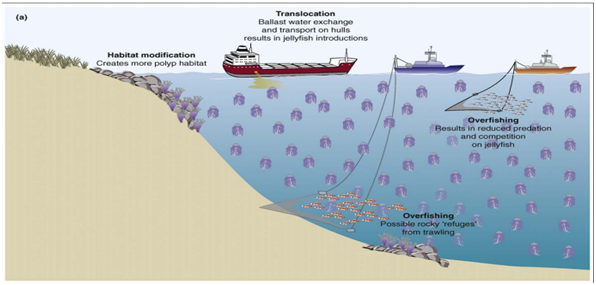
Figure 11a Shows the potential jellyfish outbreak resulting from Overfishing, Translocation and Habitat modification.32
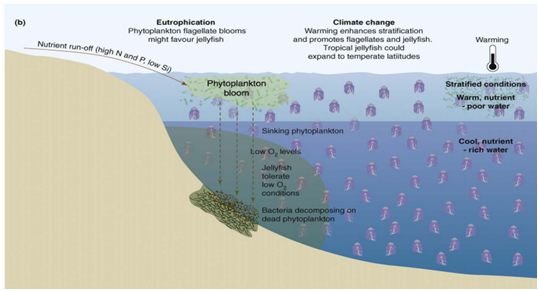
Figure 11b Shows the increase in jellyfish numbers from the causes of climate change and Eutrophication.32
Jellyfish populations and the problems they cause
Serious concerns are now becoming more frequent worldwide due to the sheer volume of jellyfish blooms, creating huge issues within fisheries, tourism, aquaculture and within marine industrial sites as shown in Figure 12.30
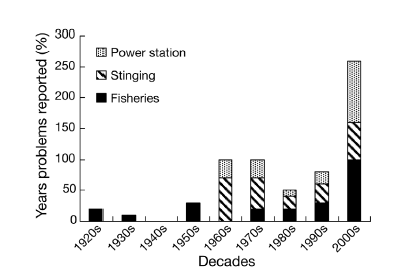
Figure 12 The increasing incident percentage rates of jellyfish induced problems towards humans over the last few decades from 1920-2000.31
Fisheries: Marine fisheries are under severe threat as a result of the vast reduction in fish populations. The East Asian Marginal Seas are the world’s most productive fishing industry, with China landing 1/3 of the world’s fish supply (Figure 13);4,31 however annual landings have been declining rapidly for more than a decade. Fish population, reproduction and growth are all being limited; possibly due to the seas being overrun with jellyfish, which are a predator of fish eggs and larvae, therefore making it near impossible for the fish to repopulate the ecosystem, as the more fish eggs are eradicated, the smaller the fish population resulting in a larger jellyfish takeover. This ecosystem shift from fish to jellyfish dominance is known as a “Jellyfish Spiral”32 and these Asian waters are ultimately heading for a jellyfish spiral.4 The last decade has seen a rise in gelatinous organisms within Asian waters, simultaneously with a decline in fishery resources (Figure 14).4,19 The most frequently reported jellyfish disturbance is reported by fishermen. Large blooms of jellyfish in popular fishing areas can cause fishing nets to split and can even poison, or contaminate the catch. Japan is a prime example of catches being ruined, as in 1990 when Aurelia aurita polluted the waters of Inland sea Seto; fish landings declined rapidly, also as in 2002 when the giant jellyfish Nomura swarmed the seas, fishing nets were continuously destroyed, while the remaining fish within the catch, were either dead, paralysed or poisoned.30
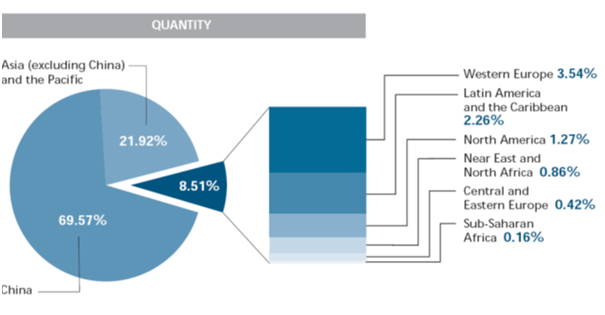
Figure 13 Shows the quantity of fish produced worldwide Sofia 2008.33
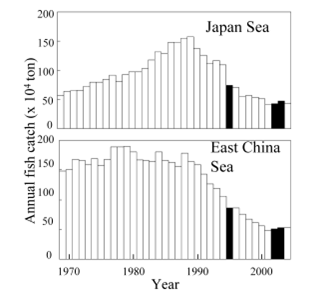
Figure 14 Shows the change in annual fish catch within the East Asian Marginal Seas, including the appearance of large jellyfish blooms (1995, 2002, 2003) in black.4
Aquaculture: Jellyfish also cause many problems with aquaculture farms (Table 3).30 with reported complaints; particularly from Japan and Scotland of manic jellyfish attacks within the pens.33 Aquaculture farms are normally found inshore within sheltered areas, however these sites are sometimes exposed to large blooms of venomous jellyfish; by brief shifts of oceanic water in which plankton are also carried, they then accumulate around the aquaculture pens and develop into a larger toxic swarm, the Jellyfish then entangle their tentacles within the pens paralysing the fish, making them useless for aquaculture, alternately the smaller medusa may swim into the pens and suffocate the fish by irritating their gills and blocking the flow of water over them.33 however even after the swarm has died off they cause complications, as their mass decay brings a brief hypoxic water state to the farming area, which can result in the mortalities of farming organisms and the loss of thousands of pounds/dollars/euros and even the possibility of another outbreak of jellyfish.2
|
Species |
Years (Months) |
Location |
Aquaculture Damage |
Source |
|
Asia |
||||
|
Aurelia aurta (S.I) |
1950 (Jul-Sep) |
Lake Hachirogata, Akita Pref. |
Mass mortality of fish & bivalves |
.18 |
|
Porpita porpita* |
2000 (Aug-Oct) |
Kyoto, Fukui Prefs. |
Mortality of penne fish |
.24 |
|
Pelagia noctiluca* |
2004 (Apr) |
Ehime Pref. |
Mortality of penne fish |
Uye SI.4 (pers. Comm. from local fisherman) |
|
Australia/Indo-Pacific |
||||
|
Unidentified |
Before 1995 |
India |
Giant tiger prawns |
|
|
Rhizostome Scyphozoan |
2006 |
Goa, India |
Shrimp |
|
|
Europe |
||||
|
Pelagia noctiluc* |
1994 |
Brittany, France |
Salmon & Trout |
|
|
Cyanea capillata |
1996 |
Loch Fyne, Scotland |
Thousands of Salmon killed, GB £ 250,000 loss |
.38 |
|
Solmaris corona* |
1997, summer |
Shetland |
Salmon killed |
|
|
Solmaris corona, Phialidium sp., Leuckartiara octona, Catablema vesicarium |
2001-2002(Aug) |
Isle of Lewis in the Outer Hebrides, Scotland |
2747680 Salmon killed in 11 incidents, GB £ 5 million loss |
|
|
Apolemia uvaria* |
1997-1998 (Nov-Feb); 2003 |
West coast of Norway |
Killed salmom; 600 tons killed |
|
|
North America |
||||
|
Moerisia lyonsi |
1970s; 1994-1997 (May-Oct) |
Mesocosms, Louisiana & Maeyland, USA |
Killed decapods; ≤ 13.6 medusae |
|
Table 3 Published reports of jellyfish interfering with aquaculture farming around the world. (“Species indicated with * are holoplanktonic; all others have a benthic stage”).31
Tourism: Jellyfish are also creating problems for tourism hotspots worldwide; with the increasing number of beach goers being stung each year increasing (Figure 15)30 causing resulting in medical emergencies and even fatalities. This being said, the number of holidaymakers going to certain holiday destinations is declining significantly as a result of the infestation of medusa in these warm, tropical waters (beaches with a sea of jellyfish are highly undesirable and are therefore detrimental to tourism).34. Stings from Physalia species for example ‘The Portuguese man o' war’ Physalia physalis cause the most damage to swimmers on a global scale, therefore; methods of defence have now been put in place using flags and alerts to warn bathers of potential encounters with jellyfish35 nevertheless, irrespective of these new implements, tourism numbers are continuously reducing due to the unwelcoming sting of the jellyfish populating the coastal waters. Even so, as the human population is also ever growing and coastal activities are still so desirable, stings towards human beings are said to become a far more increasing problem within the next few year, portraying things may potentially be getting worse,36 as the final solution would be, to close the beaches altogether.1

Figure 15 Japan’s Inland Sea Seto over populated with jellyfish; destroying fishermen’s catch.31.Industry
Finally, jellyfish are also becoming increasingly problematic within industries and power plants. They cause blockages within the coastal power plant cooling systems; clogging the intake of seawater used for cooling with their giant gelatinous bodies which results in failure for the plant to shutdown properly and causes a reduction in power loss.37,38 Such an incident requires on-going maintenance to prevent the problem, which can result in the plant being shut down for a number of weeks.30 Japan has had consistent problems with jellyfish clogging cooling systems. The problem increased so severely that records were started (recording the jellyfish biomass clogging the system daily), providing a 10 year report of the growing jellyfish abundance around the coast of Japan. Having said that; jellyfish also are problematic within diamond mining operations, by blocking the sediment suction during mining,13 they also cause interference with acoustic fish assessments, by burying the fish within their large mass, therefore making it near impossible for the sound waves to target the fish instead of the jellyfish.39
Jellyfish aren’t all bad
As problematic as jellyfish are towards human activities and the marine ecosystem, they also play a large role in the stability and maintenance of the food web and are often considered to be important components within the marine world.1 Jellyfish are a known food source for “124 different species of fish and another known 34 species of animal”40 whether they feed predominantly or occasionally on this species. The jellyfish are the main source of nutrition for many an animal, including the highly endangered Leather Back Turtle.40 Jellyfish are also known protectors of young, juvenile fish for example Horse Mackerel Trachurus trachurus. The young of many fish species when they first find themselves alone, seek refuge under and around the bell of a jellyfish, or within a large jellyfish bloom. The jellyfish protect the young from predators unable to attack the stinging tentacles, the young fish then feed on the parasites and prey of the jellyfish; hypothetically improving the amount of fish in one area, portraying that the jellyfish act as a device to attract a range of fish, which can even benefit fisheries in some situations.41 Having said this jellyfish also are now being recognised for their beneficial effects towards humans. Jellyfish are the product of a widely eaten delicacy across the world and have been consumed in China since 300AD.1 Fisheries worldwide are now producers of jellyfish, harvesting over 425,000 tonnes annually to satisfy the high Asian demand for this delicacy.1 Having said this, the increase of jellyfish is satisfying this high demand, with high landings of jellyfish each year. However jellyfish in recent years are becoming even more overtly beneficial towards humans as recent medical studies have discovered that jellyfish may hold potential medical values for many diseases and infections; including arthritis, menstrual pains and gout.42 Recent studies on lab rats have discovered that jellyfish collagen suppresses arthritis in the rats42 and stimulates the immune system and inflammatory responses in humans.43 With this in mind, jellyfish may offer more to the human populous than previously believed however with the numbers far exceeding the needs of mankind and marine organisms, their outbreak may soon become very unwelcome.
What needs to be done?
As the jellyfish epidemic has spread worldwide, humans are now looking in to what can be done to put a stop to this global outbreak. As Table 4 1 suggests, many strategies could be implemented to halt this apparent 'invasion', however none are without consequence and so far management responses have not provided the best outcome. Hsieh et al.42 explain that an increased global human consumption of this species is needed, as in only China it is considered a delicacy and has also been studied as an excellent modern diet food, possessing nutrient values of near to no calories and therefore could potentially help in the future with the outbreak of obesity that has become apparent in recent years, having said this there is a relatively select variety of species considered edible and not poisonous.43 Richardson et al.1 go on to say that by even increasing the amount of human consumption, it is unlikely that ecosystems will return back to their original state once the jellyfish have taken over. Another possibility that has been considered is the introduction of cannibalism, by which a species of jellyfish is added that would consume the existing jellyfish thereby decreasing the biomass.44
|
Management Responses |
Research Needs |
Benefits |
Risks and Issues |
|
Short-Term Tactical Time Frame |
|||
|
Develop Jellyfish products for food and medicine |
Increased research into processing and marketing of inedible species and into medicinal efficacy |
New industries and improved local economics; limit impact on fish recruitment and reduce biomass of spawing jelly fish |
Does not address underlying problem; depends on international market; might increase fishing pressure on non-problem species in healthy ecosystems |
|
Use cutting nets to destroy jellyfish in the water column |
Technology is in its infancy, but research needed on possibility of regeneration, impacts of resulting organic enrichment and by catch |
Destroy jellyfish, reducing spawning biomass |
Does not address underlying problem; might not switch system from one dominated by jellyfish; possibility of regeneration; might impact non-problem jellyfish species |
|
Destructively clean artificial hard structures and prevent settlement |
Accelerate development of environmentally benign chemicals for anti-fouling; identify 'poly' beds for problem jellyfish species |
Destroy benthic polyps and prevent settlement, thereby reducing jellyfish numbers |
Most polyp beds yet to be found so large-scale benthic surveys needed; not practical on a large scale; threat of toxic bioaccumulation |
|
Use of biocontrol agents |
Identify potential biocontrol agents for benthic polyps. Most biocontrol research is in terrestrial systems: what theory and lessons are transferable to marine ecosystems and what needs to be developed |
Selectively control jellyfish numbers and reduce spawning biomass |
Most jellyfish nonselective predators, so risk of control agent outbreaks and impact on no problem jellyfish species |
|
Stop jellyfish reseeding programs |
Assess whether jellyfish reseeding programs cause problem jellyfish blooms, especially for countries downstream |
Reduce likelihood of pushing systems(including those downstream) over tipping point to one dominated by jellyfish |
Economic benefits for those countries currently reseeding must be balanced against potential risks |
|
Enforce hull-cleaning measures and ballast water protocols Stop or restrict trans-regional aquarium trade in live jellyfish |
Develop methods to treat ballast water to kill potential invasive species and improve protocols identification of jellyfish species that pose little translocation risk |
Minimize accidental introductions of jellyfish and polyps reduce likelihood of accidental introductions |
Impacts of Oceanic ecosystems unknown |
|
Jelly fish are major attractions, but perhaps only local species should be used |
|||
|
Long Term Strategic Time Frame |
|||
|
Reduce eutrophication |
Research into jellyfish feeding ecology, and into how ecosystems resilience is enhanced by reducing multiple stressors on marine systems |
Reduce algal blooms, increase O2 in bottom waters and favour competitors and predators of polyps such as fish |
Relatively easily managed in a region (cf. climate change) |
|
Reduce overfishing |
Ongoing development of an ecosystem approach to fisheries management research to fisheries management; research into conservation of obligate jellyfish predators, such as some turtles and sunfish |
Increase competitors and predators of benthic polyps and pelagic medusae; lessen polyp fragmentation |
Difficult to control, especially in the open oceans |
|
Minimize global warming |
Ongoing research supporting energy efficiency and move toward energy sources with lower greenhouse gas emissions |
Favour food webs dominated by diatoms and fish rather than by flagellates and jellyfish |
Requires government responses globally, already committed to substantial warming because of the amount of CO2 already emitted |
Table 4 Possible management reactions and directed research necessary to preclude ecosystems from switching to being dominated by jellyfish and to return those ecosystems already dominated by jellyfish to pre-jellyfish states 1
An experiment in the black sea was conducted doing just this, in which the centaphore Beroe was added to the water and began consuming the Mnemiopsis, the overall biomass did in fact decrease and this suggested that direct jellyfish removal of controlled circumstances may be beneficial.45 Following the drop in communism in the 1990s, the outcome condensed fertiliser usage; reducing increased nutrients and improving oxygen to the water; this resulted in a reduction in jellyfish biomass and minimised hypoxic areas in the sea, returning the black sea’s ecosystem to a more desirable gelatinous free state.29 Management responses are proving unsuccessful and recent studies are now suggesting that more evidence and observation programmes are now needed to research the jellyfish outbreaks and an urgent long-term solution is needed to put a stop to this continuously thriving species. New equipment is now being developed to increase the number of successful research studies, such things as advances in acoustic and underwater surveying, also advances in molecular and video methods to monitor behaviour and survival techniques of these unique animals are being put in place, along with indicators for jellyfish outbursts.44 Very little is known about jellyfish and it seems fair to say that more fundamental research needs to be conducted to improve what is known of their role in the ecosystems. Near to nothing is known about the polyp stage and if in fact that the increased hard substrate areas around the coastline are indeed causing the increase.1
Limited knowledge of the jellyfish diet is apparent; with only tiny amounts of knowledge known for a small number of species; this has now become vital to develop across the jellyfish taxa.40,46 An expansion on experimental work is currently in process to regulate the exact effects of climate change on this species, to determine whether temperature change does in fact create long-term physiological effects on the jellyfish and their polyps.2 Hay also suggests that research into the effects of Ph. and light balance is needed to be examined to define the effect on certain medusa.46-50 And finally the benefits of consumption of certain jellyfish on a medical front needs to be expanded, as jellyfish collagen has been proven to assist in the treatment of selected diseases, therefore, these invasive pests could potentially hold a purpose in the eyes of the human.42
In conclusion, many studies have illustrated that a global jellyfish ‘invasion’ is at taking place throughout the world.1,2,4,13,44 Recent studies show that this increase has risen dramatically within the last decade; suggesting that as the global economy expands and develops into a more profitable, overseas shipping industry, negative effects are consequently increasing, leaving lasting effects on the ecosystem and the diversity of many marine organisms. Such studies provide credible evidence, related to a numbers of areas of the world, suggesting that there is a ‘silent invasion’ of jellyfish in motion and portray that future human activities could potentially save the planet from an undesirable takeover of jellyfish dominating the oceans. Intense increases in landings due to overfishing and by-catch are ensuing extreme strains on the global fish population and the natural balance of the ecosystem4,13,20,23 resulting in a predatory gap; awaiting jellyfish domination.
Decreases in jellyfish predators20,23 are also working in their favour, as polyp and medusae mortality rates have dropped rapidly since the millennium, producing an increased jellyfish biomass and a greater global population ratio then the norm a decade ago. Jellyfish have the ability to survive and thrive in the most extreme conditions due to their unique evolution; providing them with many effective attributes that allow them to reproduce and grow effectively in challenging marine environments1 certain attributes they possess which allow them to be so versatile include; their broad diet of phytoplankton, zooplankton, detritus and the larvae/eggs of many fish, efficient and fast growth and reproduction rates alongside quick development.1,3 Their ability to shrink when starved conserves energy in a fashion by which most animals would not be able to cope and would surely die of starvation, additionally their ability to rapidly recover from the negative effects of existing within a poor environment when presented with improved conditions, without causing long term damage to themselves, gives them an evolutionary edge over the majority of marine species that have to migrate away from the fast changing ocean and lastly their ability to withstand hypoxic water conditions and even thrive in them, provides them with a natural advantage over most organisms which cannot survive in these states, e.g. copepods and mollusks, gives the jellyfish the potential to once again rule the oceans and become the dominant aquatic species.12
These characteristics give the jellyfish the upper-hand over many marine species negatively affected by over-fishing, climate change, translocation, habitat modification and eutrophication, suggesting the hypothesis that if anthropogenic activities do not drastically change in the near future, then a gelatinous ecosystem is a consequence that future generations could be faced with.50 Research has recently been done in to trying to cure the problem, however scientists have suggested that emphasis on preventing the increasing blooms would be far more beneficial than trying to curing an overall population escalation. Early action against the jellyfish could be crucial to avoid large scale alterations to the pelagic ecosystems. Concern for 3rd world countries dependant on fish to provide daily nutrients and protein should be paramount, as with an expanding human population, developing countries dependant on the ocean could be faced with challenging situations within marine environments in future years.1,51,52
Rising global temperatures are said to be creating a large number of problems. As the global warming epidemic is rapidly beyond control, studies provide critical evidence showing events of jellyfish swarms coinciding with global warming events such as El Nino,13 emphasising that as the future of global warming increases, jellyfish will also increase in biomass, population and size across the world.53 There is sufficient evidence to suggest that the current influx in jellyfish population is not an anomaly within nature and that certain anthropogenic activities are in fact a cause for the increased organism invasion which must be controlled,40 this being said detailed evidence suggests that jellyfish are dominating the world’s oceans, however research must be completed to improve the available knowledge of the causes for jellyfish blooms and eventually to control the situation and understand how to either beat these ever evolving creatures or at least live amongst them, as little knowledge is known about these fascinating “immortal” organisms. Without definitive knowledge about jellyfish life cycles, migratory patterns or diets, little can be done to understand them and learn from them, considerably more research is needed on these organisms to provide answers prior to this impending issue.54
The jellyfish invasion is a very real worldwide problem, as a result of which many different life forms are affected, if jellyfish population does continue to increase in the next decade as in the past, studies suggest that the results would be catastrophic and fishing, tourism, costal industries and the ecosystem of the seas would be deeply affected.4,19,30,35 In 1999 the Caspian Sea was invaded by Mnemiopsis, the species spread so rapidly (completely occupying the sea by 2000) that the event created immense panic amongst scientists Graham & Bayha55 this same panic is now once again rife and a considerable amount of in depth research is needed to understand these creatures and possibly end their global reign, before the problem is irreversible as research suggests that, jellyfish do in fact unfortunately seem to be taking over the world.1,4,9,30
None.
None.

©2015 Williams. This is an open access article distributed under the terms of the, which permits unrestricted use, distribution, and build upon your work non-commercially.